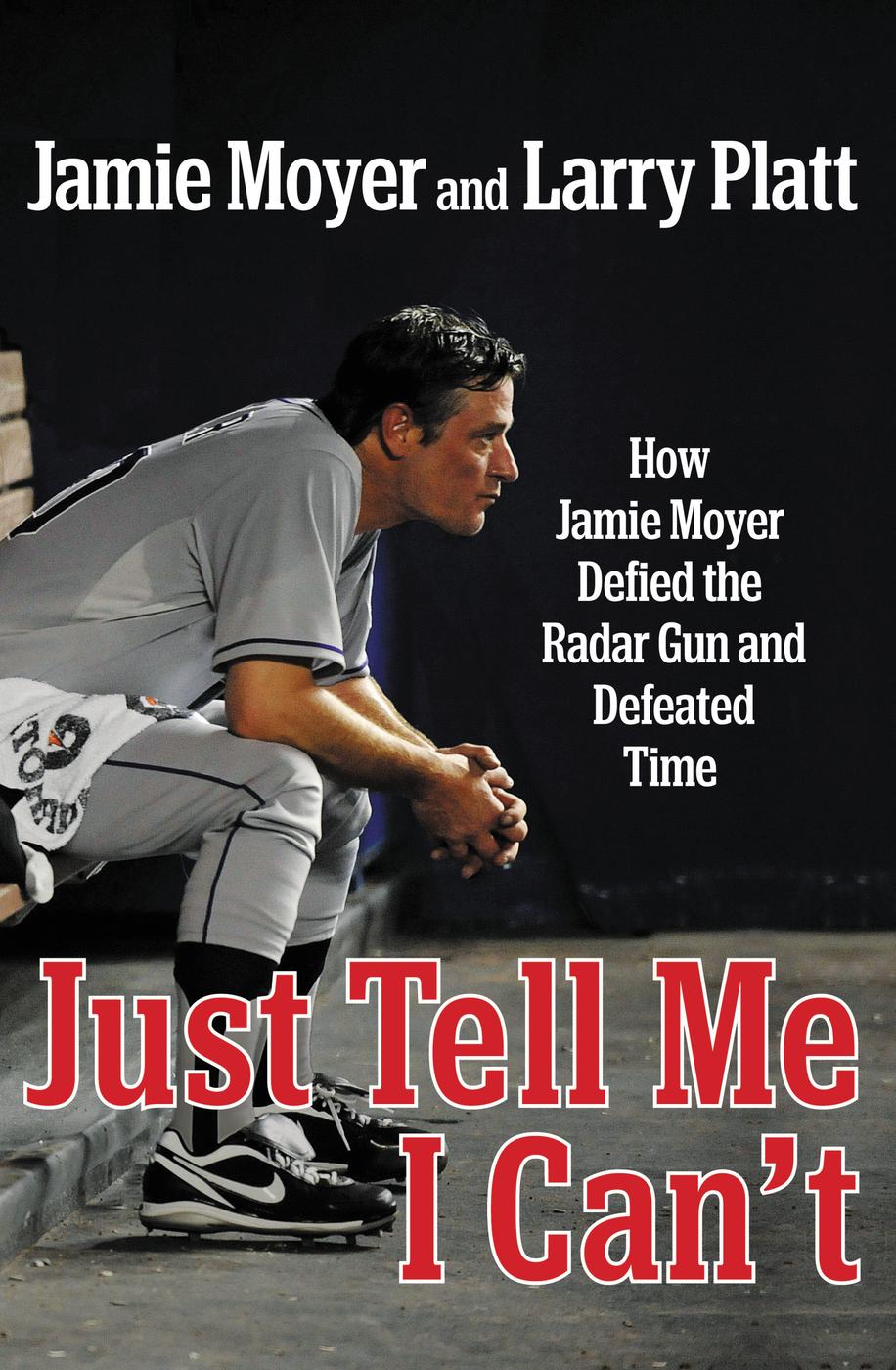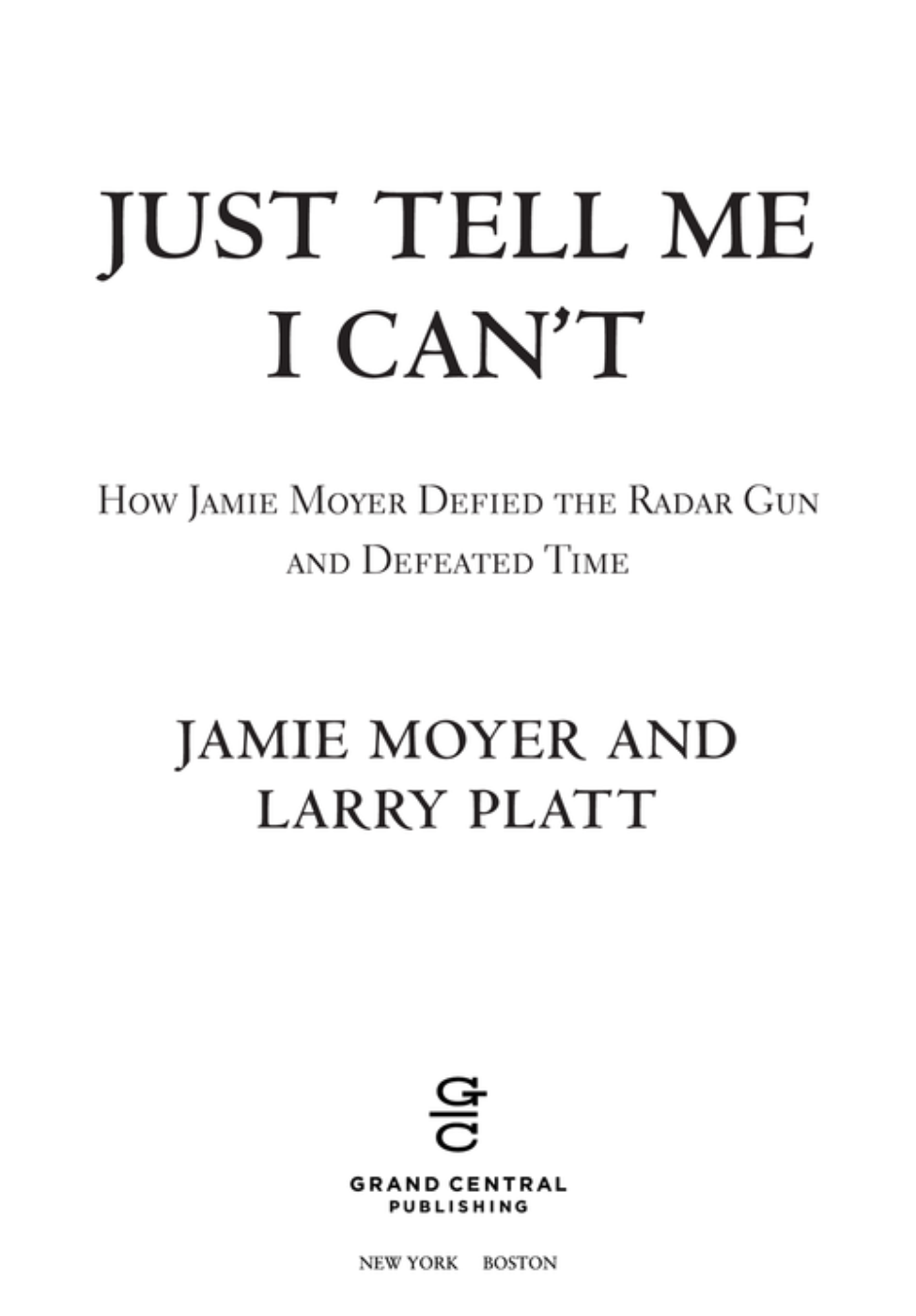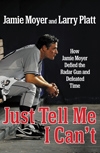Just Tell Me I Can't
Read Just Tell Me I Can't Online
Authors: Jamie Moyer




In accordance with the U.S. Copyright Act of 1976, the scanning, uploading, and electronic sharing of any part of this book without the permission of the publisher constitute unlawful piracy and theft of the author's intellectual property. If you would like to use material from the book (other than for review purposes), prior written permission must be obtained by contacting the publisher at [email protected]. Thank you for your support of the author's rights.
For Harvey Dorfman
How old would you be if you didn't know how old you are?
âSatchel Paige
I
t had been many years since Jamie Moyer was unable to quiet the chattering distractions of his own mind. But now, on a sweltering St. Louis night, the oldest athlete in all pro sports was in trouble on the mound. No matter how often he pleaded with himself to just
focus
, the doubts, laced with fear, kept coming.
His first pitch in the first inning had been a down-and-away two-seam fastball to Cardinals leadoff hitter Felipe Lopez; the two-seamer, gripped along (as opposed to across) the ball's stitches or seams, looks like a straight fastballâbefore its angled spin causes it to suddenly sink. Moyer, who has kept notes on every batter he's ever faced, knew that Lopez was often tempted to chase sinkers that sizzled and dipped toward his ankles. Upon releasing the pitch, however, with his trusted left arm raised to its three-quarters release point above his shoulder, Moyer felt something. It wasn't a searing pain; it was more as though there were a rubber band inside his elbow, and it was stretching and expanding and elongatingâ¦and then, as if on cue after the release, the pain came. And so did the ball. Lopez flailed at the pitch and weakly tapped it back to the pitcher. Moyer grabbed it while instinctively trying to hide that his arm felt like it had exploded.
The ball in his glove presented a problem.
How do I get this to first base?
Moyer wondered. In a fraction of a second, his mind raced. He thought about sprinting the ball over to first baseman Ryan Howard, but Lopez was already halfway down the line. Should he underhand it? That was too far. Now Lopez was two-thirds of the way there. Moyer raised his throbbing left arm and lobbed the ball, a soft toss that Howard caught for out number one.
As Moyer went for a slow walk around the mound, the thoughts kept coming.
Will I be able to pitch batting practice to my boys? Is this the last time I'll be on a mound? Will I go on the DL?
Moyer knew these thoughts for what they were: negative self-talk. Two decades earlier, he was a losing pitcher in his early thirties with a career 34â54 record who had been cut by three teams. The mound was a scary, powerless place; is there a more solitary spot in sports? The pitcher stands elevated, exposed, part of a team while simultaneously apart from it. He's alone with his thoughts, emotions, and countless other voices; on the mound, the withering doubts of othersâfans, media, managersâcan often drown out the game's actual sound. Those voices have crippled more pitchers than any actual succession of line drives.
But then he made a pilgrimage to the man a whole generation of ballplayers had come to refer to as “baseball's best-kept secret.” Harvey Dorfman was the raspy-voiced guru who had practically invented the field of sports psychology. Dorfman, who passed away at seventy-five early in 2011, had helped some of baseball's biggest names shed their self-consciousness. Among the disciples of the Cult of Harvey: slugger Alex Rodriguez, pitchers Roy Halladay, Greg Maddux, and Jim Abbott, and many more. None, however, were greater devotees than Moyer. Ever since that first meeting in 1991, Dorfman's acerbic aphorisms were with Moyer on every mound, in every jam, preceding every pitch.
And so on that St. Louis night, when the end of his career seemed imminent and the fearful thoughts came in waves, Moyer did as Harvey would have him do. He drew a deep breath, slowly exhaling. And he listened for that gravelly voice that for nearly twenty years had comforted him on the mound.
Focus on the task at hand.
Establish a short-term goal.
One. Pitch. At. A. Time.
Digging into the batter's box was centerfielder Randy Winn, Moyer's onetime teammate in Seattle, who had hit Moyer hard the last few years. With each pitch, the rubber band inside his elbow was pulling even more now. Moyer's changeup was in the dirt; the curveball didn't have its finish, that outward, looping wrist snap that causes the ball to arc away from lefthanded batters. In the middle of the count, Winn hit a cutter to third base for out number two.
Another out, another walk around the mound. How had he gotten here? Moyer, the thirty-sixth winningest pitcher of all time, was currently in search of his tenth win of the still-young season; he was on pace to record more wins than he had since his 16â7 record led his team, the Philadelphia Phillies, to the World Series championship two years prior, and possibly as many as he'd had seven years earlier, when his 21â7 record for Seattle made him an All-Star. He'd become something of a folk hero in Philadelphia, where middle-aged men with paunches would stop him in restaurants or on the street to share how his inspirational example had gotten them back into the gym.
Having won far more games in his forties than in his twenties, and doing so with an 81-mile-per-hour fastball and a changeup that lived on the black corners of home plate, Moyer had come to enjoy testing himself against testosterone-fueled twentysomethings; he'd gotten expert at using young hitters' machismo against them. After each called third strike or weak grounder to short, they'd take the walk of shame back to their dugout, befuddled and embarrassed that this seeming thrower of junk had once again bested them. “Jamie carved us tonight,” Atlanta Brave Chipper Jones said after Moyer threw a two-hit shutout against his team in May 2010. “The guy is eighty-seven years old and still pitching for a reason. He stays off the barrel of the bat. He changes speeds, changes the game plan, keeps you guessing.”
Oh, sure, his teammates would razz him; shortstop Jimmy Rollins would call him “Grandpa,” and on “Turn Back the Clock” uniform nights, someone would invariably joke that this wouldn't be the
first
time Moyer wore a 1929 uniform. But that was all in good fun. He'd come to embrace his role, as he put it, “representing the fortysomethings.”
But now it was all suddenly in jeopardyâthe pursuit of 300 wins (he was 33 shy of the magic number that assures a spot in Cooperstown), the folk hero status, the very way he'd defined himself his whole life. He knew what Harvey would say:
Shut up and breathe.
Moyer inhaled deeply and reminded himself:
Every pitch with purpose
.
Next up was only the best hitter in the National League, Albert Pujols. He took ball one, down and away. After a fastball at the knees, Moyer came inside with a cutter. This version of the cutter was Moyer's newest pitch, and it was largely why his 2010 season had thus far defied expectations. During the 2009 World Series his boyhood idol, Phillie great Steve Carlton, was to throw out the first pitch of game four, with Moyer catching him. As they warmed up before the game, Carlton started tossing his legendary slider. “Can you show me that?” Moyer asked. For the next half hour, he received a tutorial on the slider, which differs from a cutter only in degree; the slider's spin is tighter. Moyer had thrown a cutter since the early '90s, but this one was vastly dissimilar, with a different grip and more bite. Moyer worked on the pitch all off-seasonâwithout telling anyone on the Phils' coaching staff. When he got to spring training, it took a while before pitching coach Rich Dubee asked, just what was that pitch that seemed to be fooling so many hitters?
Moyer tried to jam Pujols with the cutter, a difficult enough proposition when the hitter
isn't
the best in baseball. The plate, after all, is a mere seventeen inches wide, framed along the outside by a thin black strip. The goal for a nonâpower pitcher like Moyer in what he calls the “ultimate game of truth or dare” is to keep hitters off balance by consistently hitting the plate's black corners. When a pitcher says he made a “mistake,” it's often because he has thrown “white on white”: the white ball over the white part of the plate. Moyer's pitch to Pujols was barely off, catching perhaps a half inch of the white, enough for the slugger to swing and muscle a bloop base hit over the infield.
The next hitter, leftfielder Matt Holliday, mimicked Pujols, fighting off an inside cutter for a soft single. Moyer took another walk, letting his arm pain subside. Rightfielder Allen Craig was a rookie who had never seen Moyer before. Early in the count, the runners stole second and third.
Moyer went for another walk, looked around the stadium.
God, I love it here
, he thought to himself, looking up at the stands, taking in the sceneâin case this was his last time on a big league mound. Harvey's voice in his head caught it:
You think you're focusing, but are you? Are you really?
Return to your breath. Slow it down.
Dorfman used to say that the adrenaline rush when in a jam on the mound was not unlike scurrying around doing last-minute chores while getting ready to go somewhere. You get nervous and tense; a modicum of doubt can result in a
deficit
âa Harvey wordâof conviction behind the pitch. And a pitch that lacks conviction is a pitch asking to be punished. In Baltimore in 1993, while lessons from Harvey were still sinking in, Moyer heard his teammate Doug Jones say that when things got loud, he'd get softer. When the fans are screaming and your thoughts are racing, the tendency is to grip the ball harder, rear back, and throw with all your might. Instead, Moyer learned, throwing it softer is the more aggressive act.
His arm throbbing, Moyer started Craig with soft stuff, away. Then he decided to throw a four-seam fastballâhis only straight pitch, gripped across the ball's horseshoe-shaped stitchesâright down the middle, white on white.
Here it is, let's see you hit it.
Allen hit a tame fly ball to Shane Victorino in centerfield to end the inning.
Walking into the dugout, Moyer called over pitching coach Dubee and manager Charlie Manuel. And then he said the three hardest words he'd ever had to say, words that, when he'd recall them months later, would still bring a quiver to his voice: “I can't throw.”
 Â
So began the most improbable of comebacks, in a life filled with them. Most mere mortals would have quit when cut by the Texas Rangers in 1991 with a career 34â49 record. Or a year later, after an 0â5 season. Or the season after that, when the Chicago Cubs offered him a job as a pitching coach. Instead, he took a flyer on handling mop-up duty for the Toledo Mud Hens for all of $12,000.
Moyer persevered after all those setbacks, but nowâwith a serious arm injury that would require Tommy John surgery in 2010âwas this the end? Not hardly.
I first met Moyer and his wife, Karen, just weeks after the injury in St. Louis. It was Phillies Alumni Weekend, and we met in a hotel bar to talk about collaborating on a book. Moyer was lukewarm; he'd read athlete autobiographies, and he'd never liked them. “I'm not a me, me, me kind of guy,” he said apologetically.
Besides, he may not have been done on the mound. Phillies general manager Ruben Amaro and virtually every sports yakker on the airwaves had loudly proclaimed his career to be over. But I got the sense that Moyer was still penning his own type of cliffhanger. “He's already plotting his comeback,” Karen said, only half joking. As we chatted, none other than Steve Carlton stopped by. For hours, the two legends talked pitching. They talked about Cole Hamels's arm slot: “He's really seeing those lanes,” Lefty said.
“He's dialed in,” Moyer agreed.
Members of an elite, exclusive club, they spoke in a cryptic, knowing shorthand. Each one seemed to know precisely what it was like for the other;
What it's like
. That's the book, I thought; not Jamie Moyer's life story so much as a biography of a master craftsman. Not some linear career blow by blow, but a travelogue of critical points of challenge, small moments examined closely.
I had just finished reading Christopher McDougall's compelling
Born to Run
, which in its profile of the record-breaking distance running of the Tarahumara Indians of Mexico's Copper Canyon, illustrated the power of mind over matter. Now, as Moyer and Carlton compared notesâ596 major league wins between them!âit struck me that they spoke far more about the mental side of the game than the purely physical. As the beer flowed into the night, modern-day pitchers were dissected as much for their perseverance and focus as for their movement and velocity. Moyer and Carlton were indeed talking craft, but they spoke in clipped sentences about the
psychology
behind the act.
Later, approaching last call, I made this observation to Moyer, and it struck a nerve. He'd learned firsthand the wisdom in the legendary Yogi Berra Zen koan: “Ninety percent of this game is mental, and the other half is physical.” Moyer had learned, he said, that “pitching takes place from the neck up.” He excitedly started walking me through all he had learned at Dorfman's knee. How important having a persona is, for example. There had long been two Jamie Moyers. One, the Clubhouse Gentleman, was the thoughtful, accessible favorite of the media pack due to his willingness to hold forth like an academic on pitching. The Clubhouse Gentleman, who never refused an autograph and who, with his wife, heads a charity foundation that is the model for how pro athletes can make a difference, had long been regarded throughout the game as a loyal teammate and a class act.
And then there's the Inner Warrior. It's the Inner Warrior who comes to the fore when Moyer, his eyes narrowed to intense slits, refers to the pitching mound as “
my
f'ing circle.”
Moyer learned, as Carlton had before him, that a pitcher's body language was inextricably linked to his success. He'd watched an early mentor, Nolan Ryan, walk off the mound during an away game only to have a rabid heckler drench the flamethrower in beer. But the indomitable Ryan never even broke stride, his hard-edged sneer firmly in place, while the opposing dugout looked on. The game, at that point, was over. For Moyer, it was an object lesson: if you let opposing batters see you sweat, they'll race each other to the on-deck circle. And if they think you have an otherworldly composure and nerves of granite, they'll begin to doubt themselves, if even slightly.